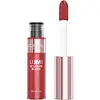What's inside
What's inside
 Key Ingredients
Key Ingredients

 Benefits
Benefits

 Concerns
Concerns

 Ingredients Side-by-side
Ingredients Side-by-side

Water
Skin ConditioningDimethicone
EmollientTrimethylsiloxyphenyl Dimethicone
Isotridecyl Isononanoate
EmollientButylene Glycol
HumectantMica
Cosmetic ColorantTin Oxide
AbrasiveTrimethylsiloxysilicate
EmollientGlycerin
HumectantPolymethylsilsesquioxane
Methyl Hydrogenated Rosinate
PerfumingSynthetic Fluorphlogopite
Cetyl PEG/PPG-10/1 Dimethicone
EmulsifyingPEG-10 Dimethicone
Skin ConditioningMagnesium Sulfate
Silica
AbrasiveMethicone
EmollientMagnesium Stearate
Cosmetic ColorantPhenoxyethanol
PreservativeEthylhexylglycerin
Skin ConditioningGlyceryl Behenate/Eicosadioate
EmollientDisodium EDTA
Titanium Dioxide
Cosmetic ColorantIron Oxides
Water, Dimethicone, Trimethylsiloxyphenyl Dimethicone, Isotridecyl Isononanoate, Butylene Glycol, Mica, Tin Oxide, Trimethylsiloxysilicate, Glycerin, Polymethylsilsesquioxane, Methyl Hydrogenated Rosinate, Synthetic Fluorphlogopite, Cetyl PEG/PPG-10/1 Dimethicone, PEG-10 Dimethicone, Magnesium Sulfate, Silica, Methicone, Magnesium Stearate, Phenoxyethanol, Ethylhexylglycerin, Glyceryl Behenate/Eicosadioate, Disodium EDTA, Titanium Dioxide, Iron Oxides
Water
Skin ConditioningDimethicone
EmollientIsododecane
EmollientButylene Glycol
HumectantAlcohol
AntimicrobialAcrylates/Polytrimethylsiloxymethacrylate Copolymer
Skin ConditioningCetyl PEG/PPG-10/1 Dimethicone
EmulsifyingTrimethyl Pentaphenyl Trisiloxane
EmollientSynthetic Fluorphlogopite
Disteardimonium Hectorite
StabilisingPolyglyceryl-4 Isostearate
EmulsifyingMagnesium Sulfate
Phenoxyethanol
PreservativePropylene Carbonate
SolventPEG/PPG-18/18 Dimethicone
EmulsifyingSilica
AbrasiveTin Oxide
AbrasiveCalcium Aluminum Borosilicate
Disodium Stearoyl Glutamate
CleansingAluminum Hydroxide
EmollientPentaerythrityl Tetra-Di-T-Butyl Hydroxyhydrocinnamate
AntioxidantTocopherol
AntioxidantMica
Cosmetic ColorantCI 77891
Cosmetic ColorantCI 77491
Cosmetic ColorantCI 77499
Cosmetic ColorantCI 15850
Cosmetic ColorantCI 15985
Cosmetic ColorantCI 19140
Cosmetic ColorantCI 77510
Cosmetic ColorantWater, Dimethicone, Isododecane, Butylene Glycol, Alcohol, Acrylates/Polytrimethylsiloxymethacrylate Copolymer, Cetyl PEG/PPG-10/1 Dimethicone, Trimethyl Pentaphenyl Trisiloxane, Synthetic Fluorphlogopite, Disteardimonium Hectorite, Polyglyceryl-4 Isostearate, Magnesium Sulfate, Phenoxyethanol, Propylene Carbonate, PEG/PPG-18/18 Dimethicone, Silica, Tin Oxide, Calcium Aluminum Borosilicate, Disodium Stearoyl Glutamate, Aluminum Hydroxide, Pentaerythrityl Tetra-Di-T-Butyl Hydroxyhydrocinnamate, Tocopherol, Mica, CI 77891, CI 77491, CI 77499, CI 15850, CI 15985, CI 19140, CI 77510
Ingredients Explained
These ingredients are found in both products.
Ingredients higher up in an ingredient list are typically present in a larger amount.
Butylene Glycol (or BG) is used within cosmetic products for a few different reasons:
Overall, Butylene Glycol is a safe and well-rounded ingredient that works well with other ingredients.
Though this ingredient works well with most skin types, some people with sensitive skin may experience a reaction such as allergic rashes, closed comedones, or itchiness.
Learn more about Butylene GlycolThis ingredient is a high molecular weight silicone. It has emulsifying and skin conditioning properties.
Dimethicone is a type of synthetic silicone created from natural materials such as quartz.
What it does:
Dimethicone comes in different viscosities:
Depending on the viscosity, dimethicone has different properties.
Ingredients lists don't always show which type is used, so we recommend reaching out to the brand if you have questions about the viscosity.
This ingredient is unlikely to cause irritation because it does not get absorbed into skin. However, people with silicone allergies should be careful about using this ingredient.
Note: Dimethicone may contribute to pilling. This is because it is not oil or water soluble, so pilling may occur when layered with products. When mixed with heavy oils in a formula, the outcome is also quite greasy.
Learn more about DimethiconeMagnesium Sulfate is a salt. More specifically, it is an epsom salt, or the bath salt used to help relieve muscle aches.
Despite having ‘sulfate’ in the name, it isn’t a surfactant or cleansing agent like sodium lauryl sulfate. Unlike those sulfates, magnesium sulfate doesn’t have the same cleansing or foaming properties (it's simply a type of salt).
In cosmetics, Magnesium Sulfate is used to thicken a product or help dilute other solids. It is a non-reactive and non-irritating ingredient.
One study shows magnesium deficiency may lead to inflammation of the skin. Applying magnesium topically may help reduce inflammation.
You can find this ingredient in sea water or mineral deposits.
Learn more about Magnesium SulfateMica is a naturally occurring mineral used to add shimmer and color in cosmetics. It can also help improve the texture of a product or give it an opaque, white/silver color.
Serecite is the name for very fine but ragged grains of mica.
This ingredient is often coated with metal oxides like titanium dioxide. Trace amounts of heavy metals may be found in mica, but these metals are not harmful in our personal products.
Mica has been used since prehistoric times throughout the world. Ancient Egyptian, Indian, Greek, Roman, Aztec, and Chinese civilizations have used mica.
Learn more about MicaPhenoxyethanol is a preservative that has germicide, antimicrobial, and aromatic properties. Studies show that phenoxyethanol can prevent microbial growth. By itself, it has a scent that is similar to that of a rose.
It's often used in formulations along with Caprylyl Glycol to preserve the shelf life of products.
Silica, also known as silicon dioxide, is a naturally occurring mineral. It is used as a fine, spherical, and porous powder in cosmetics.
Though it has exfoliant properties, the function of silica varies depending on the product.
The unique structure of silica enhances the spreadability and adds smoothness, making it a great texture enhancer.
It is also used as an active carrier, emulsifier, and mattifier due to its ability to absorb excess oil.
In some products, tiny microneedles called spicules are made from silica or hydrolyzed sponge. When you rub them in, they lightly polish away dead skin layers and enhance the penetration of active ingredients.
Learn more about SilicaSynthetic Fluorphlogopite is the synthethic version of mica. It consists of fluorine, aluminum and silicate.
Synthetic Fluorphlogopite is used to add volume to products.
It is considered non-irritating on the skin.
Learn more about Synthetic FluorphlogopiteTin Oxide is an inorganic oxide used to add opacity and volume to a product. In nature, it is already found in mineral form. The main ore of tin is an opaque and shiny mineral called casseterite.
Tin Oxide helps remove translucency in a product, or make it more opaque. Besides adding opacity, tin oxide is used for bulking to add volume.
Water. It's the most common cosmetic ingredient of all. You'll usually see it at the top of ingredient lists, meaning that it makes up the largest part of the product.
So why is it so popular? Water most often acts as a solvent - this means that it helps dissolve other ingredients into the formulation.
You'll also recognize water as that liquid we all need to stay alive. If you see this, drink a glass of water. Stay hydrated!
Learn more about Water